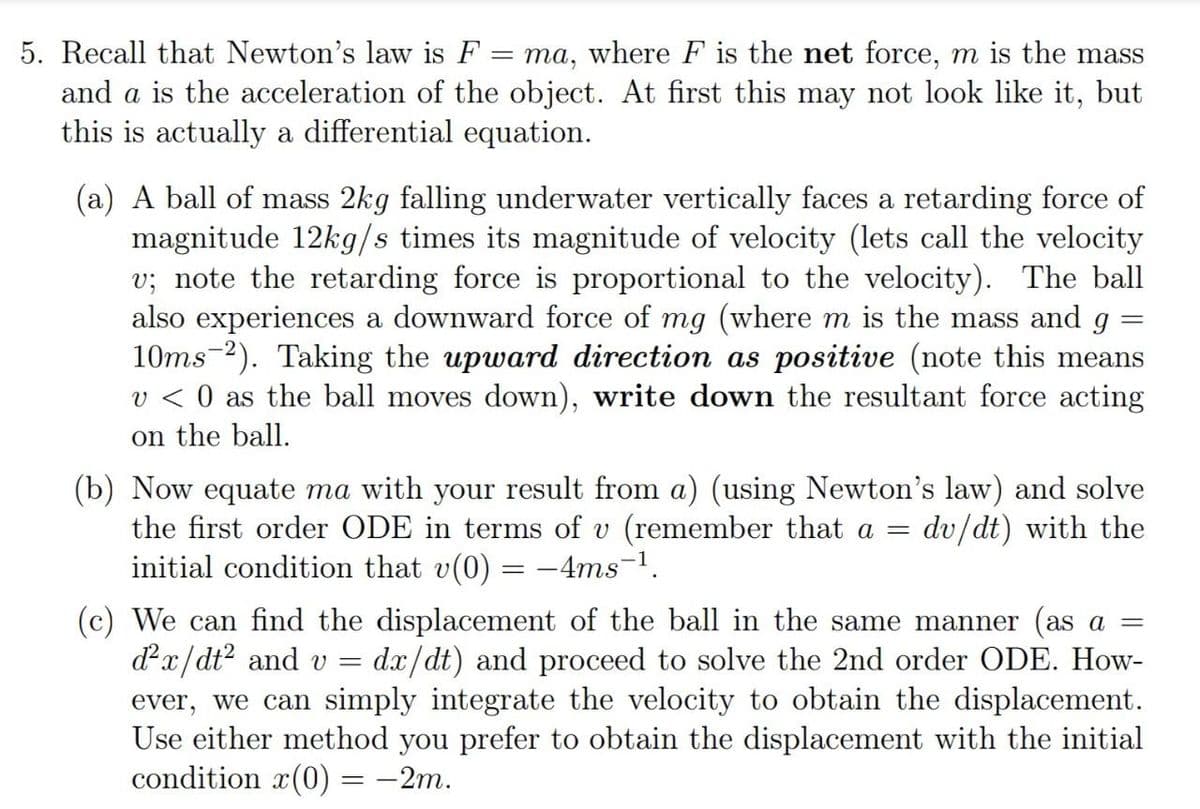nd a is the acceleration of the object. At first this may not look like it, but his is actually a differential equation. (a) A ball of mass 2kg falling underwater vertically faces a retarding force of magnitude 12kg/s times its magnitude of velocity (lets call the velocity v; note the retarding force is proportional to the velocity). The ball also experiences a downward force of mg (where m is the mass and g = 10ms-2). Taking the upward direction as positive (note this means v < 0 as the ball moves down), write down the resultant force acting on the ball. (b) Now equate ma with your result from a) (using Newton's law) and solve the first order ODE in terms of v (remember that a = initial condition that v(0) = -4ms-1. dv/dt) with the (c) We can find the displacement of the ball in the same manner (as a = d²x/dt? and v = ever, we can simply integrate the velocity to obtain the displacement. Use either method you prefer to obtain the displacement with the initial condition x(0) = -2m. dx/dt) and proceed to solve the 2nd order ODE. How-
nd a is the acceleration of the object. At first this may not look like it, but his is actually a differential equation. (a) A ball of mass 2kg falling underwater vertically faces a retarding force of magnitude 12kg/s times its magnitude of velocity (lets call the velocity v; note the retarding force is proportional to the velocity). The ball also experiences a downward force of mg (where m is the mass and g = 10ms-2). Taking the upward direction as positive (note this means v < 0 as the ball moves down), write down the resultant force acting on the ball. (b) Now equate ma with your result from a) (using Newton's law) and solve the first order ODE in terms of v (remember that a = initial condition that v(0) = -4ms-1. dv/dt) with the (c) We can find the displacement of the ball in the same manner (as a = d²x/dt? and v = ever, we can simply integrate the velocity to obtain the displacement. Use either method you prefer to obtain the displacement with the initial condition x(0) = -2m. dx/dt) and proceed to solve the 2nd order ODE. How-
An Introduction to Physical Science
14th Edition
ISBN:9781305079137
Author:James Shipman, Jerry D. Wilson, Charles A. Higgins, Omar Torres
Publisher:James Shipman, Jerry D. Wilson, Charles A. Higgins, Omar Torres
Chapter3: Force And Motion
Section: Chapter Questions
Problem 5MC: According to Newtons second law of motion, when an object is acted upon by an unbalanced force, what...
Related questions
Topic Video
Question

Transcribed Image Text:5. Recall that Newton's law is F
= ma, where F is the net force, m is the mass
and a is the acceleration of the object. At first this may not look like it, but
this is actually a differential equation.
(a) A ball of mass 2kg falling underwater vertically faces a retarding force of
magnitude 12kg/s times its magnitude of velocity (lets call the velocity
v; note the retarding force is proportional to the velocity). The ball
also experiences a downward force of mg (where m is the mass and g =
10ms-2). Taking the upward direction as positive (note this means
v < 0 as the ball moves down), write down the resultant force acting
on the ball.
(b) Now equate ma with your result from a) (using Newton's law) and solve
the first order ODE in terms of v (remember that a =
initial condition that v(0) = -4ms-1.
dv/dt) with the
(c) We can find the displacement of the ball in the same manner (as a =
dx/dt? and v =
ever, we can simply integrate the velocity to obtain the displacement.
Use either method you prefer to obtain the displacement with the initial
condition x(0) = -2m.
dx/dt) and proceed to solve the 2nd order ODE. How-
Expert Solution
This question has been solved!
Explore an expertly crafted, step-by-step solution for a thorough understanding of key concepts.
Step by step
Solved in 5 steps with 5 images

Knowledge Booster
Learn more about
Need a deep-dive on the concept behind this application? Look no further. Learn more about this topic, physics and related others by exploring similar questions and additional content below.Recommended textbooks for you

An Introduction to Physical Science
Physics
ISBN:
9781305079137
Author:
James Shipman, Jerry D. Wilson, Charles A. Higgins, Omar Torres
Publisher:
Cengage Learning

College Physics
Physics
ISBN:
9781938168000
Author:
Paul Peter Urone, Roger Hinrichs
Publisher:
OpenStax College


An Introduction to Physical Science
Physics
ISBN:
9781305079137
Author:
James Shipman, Jerry D. Wilson, Charles A. Higgins, Omar Torres
Publisher:
Cengage Learning

College Physics
Physics
ISBN:
9781938168000
Author:
Paul Peter Urone, Roger Hinrichs
Publisher:
OpenStax College


College Physics
Physics
ISBN:
9781305952300
Author:
Raymond A. Serway, Chris Vuille
Publisher:
Cengage Learning

Physics for Scientists and Engineers with Modern …
Physics
ISBN:
9781337553292
Author:
Raymond A. Serway, John W. Jewett
Publisher:
Cengage Learning

University Physics Volume 1
Physics
ISBN:
9781938168277
Author:
William Moebs, Samuel J. Ling, Jeff Sanny
Publisher:
OpenStax - Rice University